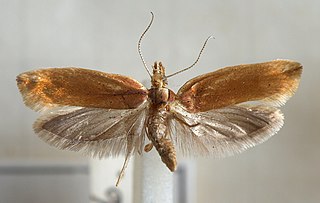
Ypsolopha ustella, the variable ypsolopha moth, is a moth of the family Ypsolophidae. It is found in most of Europe and is also present in North America.
Helcystogramma bicuneum is a moth in the family Gelechiidae. It was described by Edward Meyrick in 1911. It is known from north-eastern India and China.
Helcystogramma lithostrotum is a moth in the family Gelechiidae. It was described by Edward Meyrick in 1916. It is known from Malaysia.
Helcystogramma pantheropa is a moth in the family Gelechiidae. It was described by Edward Meyrick in 1913. It is found in South Africa.
Dichomeris melanota is a moth in the family Gelechiidae. It was described by Walsingham in 1911. It is found in Mexico (Veracruz).
Dichomeris xerodes is a moth in the family Gelechiidae. It was described by Walsingham in 1911. It is found in Mexico (Tabasco).
Dichomeris mistipalpis is a moth in the family Gelechiidae. It was described by Walsingham in 1911. It is found in Panama, Brazil and Guyana.
Helcystogramma abortiva is a moth in the family Gelechiidae. It was described by Walsingham in 1911. It is found in Guatemala.
Helcystogramma adaequata is a moth in the family Gelechiidae. It was described by Edward Meyrick in 1914. It is found in Guyana.
Helcystogramma scintillula is a moth in the family Gelechiidae. It was described by Walsingham in 1911. It is found in Mexico (Tabasco).
Helcystogramma juventellus is a moth in the family Gelechiidae. It was described by Walsingham in 1897. It is found in Jamaica and Mexico (Tabasco).
Helcystogramma septella is a moth in the family Gelechiidae. It was described by Philipp Christoph Zeller in 1852. It is found in Malawi, South Africa, Tanzania and the Gambia.
Antaeotricha trichonota is a species of moth of the family Depressariidae. It is found in Brazil and Paraguay.
Antaeotricha corvigera is a moth of the family Depressariidae first described by Edward Meyrick in 1915. It is found in Guyana and Peru.
Stenoma anetodes is a moth of the family Depressariidae. It is found in Guyana.
Chlamydastis bifida is a moth of the family Depressariidae. It is found in Brazil and the Guianas.
Lecithocera decorosa is a moth in the family Lecithoceridae. It was described by Alexey Diakonoff in 1968. It is found on Luzon in the Philippines.
Anchinia porphyritica is a moth in the family Depressariidae. It was described by Edward Meyrick in 1914. It is found in Assam, India.
Zetesima lasia is a moth in the family Depressariidae. It was described by Walsingham in 1912. It is found in Panama.
Imma synconista is a moth in the family Immidae. It was described by Edward Meyrick in 1918. It is found in Kanara, India.
